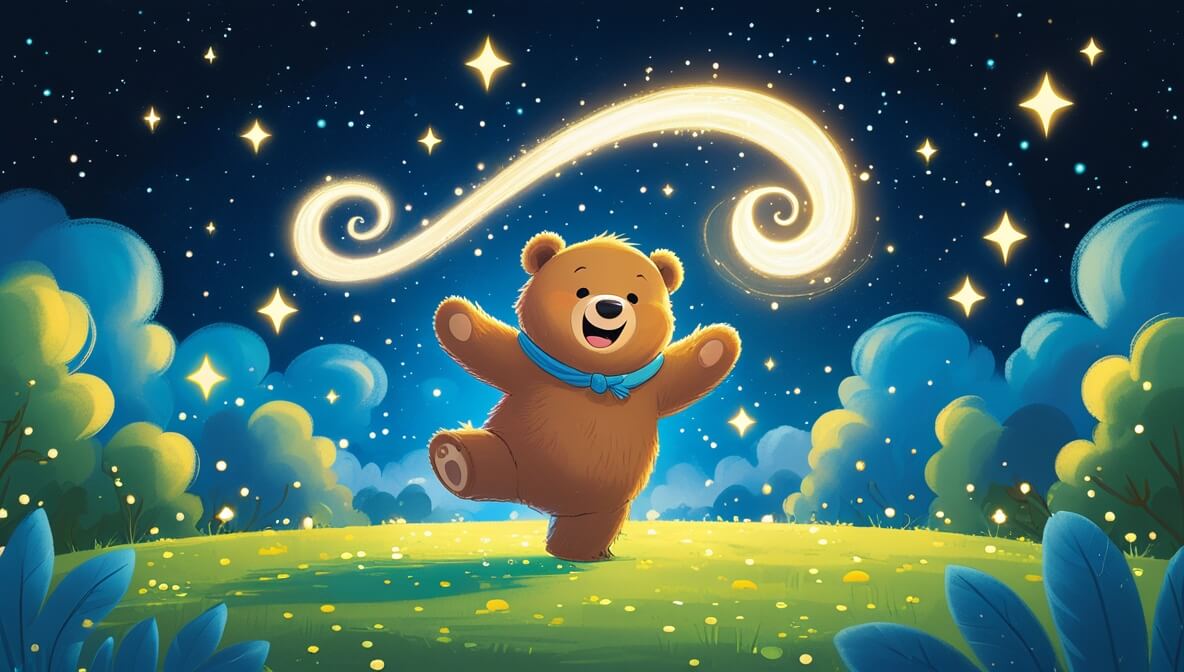Join the adventure of a little bear who discovers the magic of a friendly moonbeam. Together, they explore the night sky and learn about friendship.
Age Recommendation
0 – 4 years
Characters
Characters:
- Benny the Bear (a curious little bear who loves exploring)
- Moonbeam (a magical beam of light from the moon, friendly and bright)
Story
Once upon a time, in a quiet forest, there was a little bear named Benny. Benny loved to explore and play under the sky. One night, as the stars twinkled above, Benny saw a bright, friendly light on the ground. It was a magical Moonbeam! Benny was curious and decided to follow it.
The Night Sky Adventure
The Moonbeam danced and twirled through the trees, inviting Benny to join. Benny giggled and followed, feeling happy and full of wonder. The Moonbeam showed Benny how the stars formed shapes, like a giant bear and a dancing rabbit. Benny was amazed and clapped his paws with joy.
A Secret in the Stars
The Moonbeam whispered to Benny about a secret: the stars could talk if you listened closely. Benny closed his eyes and listened carefully. He heard a soft, twinkling song. Benny felt calm and loved, knowing the stars were his friends too.
Home with a New Friend
As the night grew late, Benny knew it was time to go home. He thanked the Moonbeam for the magical adventure and gave it a big bear hug. The Moonbeam promised to visit Benny every night, and Benny felt grateful to have such a special friend.
The end.
Moral of the Story
The story teaches that friendship can be found in the most magical places, and exploring with friends can make every adventure special.
Questions to Think About
- What do you think Benny learned from the Moonbeam?
- How did the stars make Benny feel?
- Why is it fun to explore with friends?
- What would you do if you found a magical Moonbeam?
- How can you be a good friend to others?
Do You Know
- The moon doesn’t make its own light. It shines because it reflects the light from the sun.
- Bears have a great sense of smell, which helps them find food.
Word Explorer
- Moonbeam: A ray of light from the moon.
- Curious: Wanting to learn or know more about something.
- Twirled: Spun around quickly.
Emotions in the Story
- Happy: Benny felt happy when he followed the Moonbeam through the forest.
- Loved: Benny felt loved when he heard the stars’ twinkling song.
- Grateful: Benny was grateful for his new friend, the Moonbeam.
Color Your Scene
Imagine Benny and the Moonbeam dancing under the night sky. Benny is a fluffy brown bear with a cheerful smile. The Moonbeam is a bright, shimmering beam of light. The sky is dark blue with sparkling stars. Can you draw this magical moment? Use blue for the sky, white and yellow for the stars, and brown for Benny.
Parents’ Corner
This story is a wonderful way to introduce your child to the beauty of nature and the night sky. Encourage them to explore and be curious, just like Benny. Talk about the importance of friendship and how new friends can be found in unexpected places. Discuss how Benny felt when he was with the Moonbeam and how we can make others feel loved and appreciated by being good friends.











